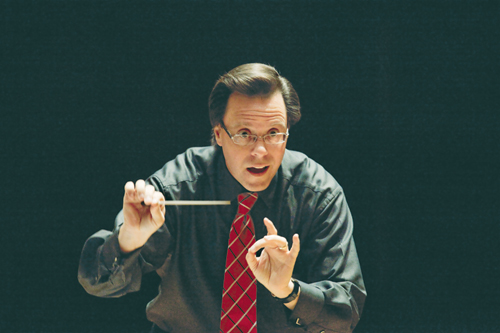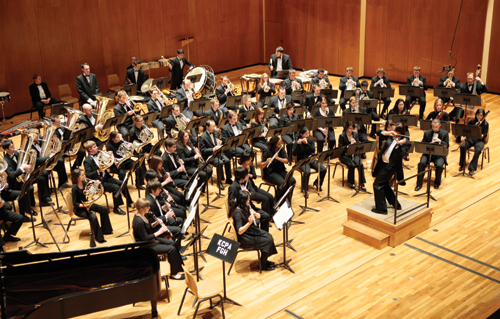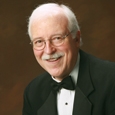
Robert W. Rumbelow is the director of bands and the Brownfield Professor of Music at the University of Illinois, joining the faculty in 2010. He conducts the Illinois Wind Symphony (the university’s premier concert band), works with graduate student conductors, and oversees all functions of the university bands program. Rumbelow has conducted bands, orchestras, and chamber ensembles around the world. He received a doctorate of musical arts degree from the Eastman School of Music and was also awarded the school’s highest conducting prize. As a composer and arranger, Rumbelow’s music is performed internationally and published by Kjos, Warner Brothers, Alfred, Ludwig/Masters, and C. Alan Publications.
How do you approach a new score?
The most important thing is to get a fresh start on a score. I get two copies of the score, one to make notes on and a second in which I will eventually mark what I believe are the most important points. In the working score, I make notes to myself, draw lines in the music, mark sections. In short, I use this score to figure out how the composer put the piece together.
I prefer to leaf through the unmarked score at first to get a sense of the big picture. I read anything written in the score by the composer, arranger, or editor, looking at all the terms used. The next thing I do is play everything on an instrument. I use the piano, but some of my students use their primary instruments. Reading through lines gives you a feel for the music as well as how each part feels. It also gives me a good idea of which musical tools the composer used. I am not looking for anything specific when reading through parts but rather just experiencing the piece a bit. This is an important part of preparation. It is common for conductors to open a score for the first time and immediately wonder how to teach something. Although it is easy to slip into this mode when coming across something difficult in the score, it is better to work toward understanding the music in depth before thinking about teaching strategies.
Recently we worked on Lincolnshire Posy. The last chord of the sixth movement is a D minor chord with an added Bn. The chord is wonderful, but it is important to figure out why that sound is there in the first place. The entire movement is D Dorian, and the raised sixth in the final chord is there to definitively state D Dorian. Now that we know why the Bn is there, the next things to address are why it is scored for the instruments it is, why it is in the tessitura that it is, and how it influences balance.
In good score study, you will go down some paths that lack fruit. You might notice an unusual rhythmic aspect, and checking whether it is used in augmentation or diminution produces nothing because that was not where the composer was going. A conductor’s job is to figure out what the composer is doing and highlight discoveries in the way we rehearse, and ultimately the way we perform. I want to know what made the composer tick when he was writing something. That is the core of it.
I avoid recordings until I have a strong mastery of a piece. Recordings are a final step for me in which I listen to other people’s decisions, catch anything I might have missed, and decide if I need to reevaluate my ideas because I hear other ideas presented in a different way. Recordings answer many questions that should be answered by you first. I think it would be a great help for young conductors to avoid going to recordings right away. Sit with the score at an instrument and get to know the piece on your own before finding recordings. Make listening the last step, after you’ve formed solid opinions based on your analytical and musical thoughts.
In what ways will good score study affect rehearsal planning?
It affects everything from the understanding of harmony to rhythm to melody. It influences the balances and colors we look for. The colors come from your understanding of which lines belong together and which ones are above and below other ones to create a color the composer is after. You have to look for that information so that the band plays more colorfully. All directors will profit from more color in the band sound. That makes music exciting.
The great example is in the Allegro after the chorales are over in William Schuman’s Chester. A chord that happens over and over again is a pan-diatonic C major collection, which means the chord uses every note in the C major scale. Knowing that gives me a rehearsal strategy. Starting with something with which my students are familiar, I pull out the D, F, and A, leaving a C major 7 chord. Students are familiar with that sound and can tune and balance it easily. Then I have the students playing the D minor chord play while the others sit out; this is another sound students are familiar with. Now they have a way to listen to each other with the two chords. When we put them back together, the intonation and balance are always better, even in young groups, because they have something to listen to. It is no longer just a mass of sound. These little discoveries provide an immediate plan to take something students know and use it to teach students something new. That connection is exciting for me to find, because it will lead me to something that helps with rehearsal strategy and even the order I demonstrate things in.
Another piece with a good example is Moving Parts by David Sampson. Looking at the melody in my score preparation, I found a couple motifs. One of these was written into the horn parts. On the parts, it just looks like three eighth notes with no connection to anything, and that was how the hornists played it until I told them it was motivic. We played it again with the horns playing those three notes with knowledgeable purpose. It changed the color of that passage immediately because they understood what their purpose was as opposed to just playing three eighth notes that meant nothing.
How does a successful rehearsal look and sound?
A good rehearsal includes attention to how the group is breathing. Band directors frequently talk about breathing, but we do not do so in terms of style and ensemble. Students should breathe together in the style of the music; this links an ensemble at a basic level. If a section breathes together, it is more likely that they will come in together, then we have good ensemble right away. This also helps produce a uniform sound and avoids fast air sounds next to slow air sounds. As soon as you can convince a band how much this matters their sound starts to align much better.
One thing I like to see in a rehearsal is a level of attention and seriousness. I want to feel the vibe that what is going on in the room is important for both conductor and students. That kind of attitude from students is especially important. They should be attentive to each other and the conductor. There should be a lot of eye contact, and reactions should be obvious; if the conductor tries something he should hear something different back.
The other thing that I like to see in rehearsal is guided listening. The conductor should make sure players know what is on the other parts. The idea that we’re guiding listening for balance, tone color, and the playing of rhythmic or melodic fragments is an important responsibility of the conductor. The big picture is only available in the score and while the ensemble plays. Conductors have a clear advantage and should share that information in rehearsal, because students need to know where they should be listening and why. In our summer master’s program I taught a course that covered how analysis influences not just the gestures but also the way you rehearse and the order you rehearse in. You may start in the middle of a work to touch on a harmony or rhythm the composer uses, so students understand what is coming up or building into it.
A successful rehearsal has a good balance between musical and technical elements. Do not postpone rehearsing musicality until the technique is set. Often the technical aspects never reach perfection, so it is unwise to wait to fix musicality. The intention may even be as obvious as stating which musical element is important and why or the need to clear up articulations in this passage so the conductor can hear what is going on. Young conductors sometimes stop too much or too early in the sequence. Sometimes we need to allow for a certain number of mistakes to happen and hope that they are not chronic mistakes, which have to be fixed. There should be priorities in what we want to address.
What are your priorities when you step on the podium at the start of a new year?
My first priority is the development of ensemble tone. They need feedback, so we play a lot, especially the beginning of the year, so I can offer ideas about tone and musicianship. I’m a big advocate of using chorales and warmups that guide the ear. Such slow warmups have a calming and focusing effect at all levels, even college. Warmups are a time to start listening for a beautiful sound rather than just hearing. To produce a beautiful sound it takes both good individual sonorities and ensemble balance. There should be a unified idea of tone quality in each section. Finding a balanced ensemble sound means figuring out such things as where the clarinet voice should be heard in a well-orchestrated triad.
How do you help an ensemble improve intonation?
There are several strategies and good exercises. One-on-one pitch bending exercises are good. Have one person bend the pitch up or down and then bring it back to match, then the other student does the same. Students should hear the waves in the pitch as it gets close. The more people playing, the less dramatic these waves become, so having students pair up to do this is best.
Directors can add a perfect interval or a pedal tone to a line. If a line is in C, add a student holding C while everyone plays the line slowly. It is the equivalent of having a snare drum player play eighth notes while everybody plays so they feel the beat. This way students can hear the constant pitch and adjust accordingly.
Young teachers should understand that developing pitch awareness is a long-term effort. It has to happen every day in rehearsal, and it is important to use every available opportunity to bring attention to pitch. Also, explain how notes function in a chord. Tearing chords apart a bit and offering information about each pitch’s function is often helpful. You can find function or a link to something they already know, whether by interval or other connection. Recently I was rehearsing a contemporary work, and the horns had a C-Db-Eb-F cluster. I pointed out that if they listened to the perfect fourth, the sound would improve. The next time they played the cluster, it sounded like a colorful chord rather than a collection of pitches. Because the emphasis was changed on the listening, it straightened everything out. Frequently students may be unsure where to listen or what their function is. Defining these things in rehearsal is an important part of clarifying intonation. It isn’t always a matter of being able to adjust; having the ears prepared and knowing where to listen is just as important.
What skills do you emphasize in conducting classes?
I emphasize body motion and conviction. I think conviction is everything. It is in the eyes, face, muscles, stance – everywhere in the body. That kind of non-verbal communication is difficult to dismiss. It takes over the room and makes it a wonderful, experience. Conviction comes from an authentic idea of what the score is. There is no question about what you want if your conviction is firm enough.
The other thing I emphasize in both graduate and undergraduate conducting is body motion. This is more than conducting gestures. I taught an undergraduate course in the fall and changed things a bit from a traditional approach. One thing we did was to work in a swimming pool for a while to feel what it was like to push water and make different kinds of splashes. A splash can go all the way across a pool, or it can have a short life. It can be full of water or use very little water. We put on some music and beat time with circles in the pool, discussing what type of splash might convey playfulness, seriousness, or lightness. It was a great example of body language in the pool, because people instinctively know what is going to happen when the water moves. This type of physical language is something we can all understand, and it also says something about weight, speed, and angle, which is essentially what defines a gesture. I wanted students to be able to use their bodies in a way that communicates what the music is trying to say. Frankly, moving through air is a little abstract.
After the pool, we spent time bouncing tennis balls to each other, sometimes fast, sometimes slowly, to talk about speed and angle. We used egg shakers to find whether we were getting an ideal beat, and to see what sound the shaker made for each beat. We held heavy, light, bulky, or smooth objects to think about the weight and shape of the music. Music might be more like holding a feather or more like pushing a desk. I tried to tap into a lot of the natural aspects of conducting, and we didn’t get to patterns until the 7th week, after 14 classes on body motion with music.
Patterns sometimes end up being an undergraduate conductor’s prison. They learn the pattern and that’s it. Students alter the size of the pattern based on dynamics, and they can also realize the tempo. All that is good for the structure of a piece, but it is unlikely to elicit a response to your vision of what the music is trying to say.
If you want your vision to come to life, you need to be able to communicate with every part of your body. Your ensemble members are taking in the general overall image of the person on the podium; not everybody is just watching the baton or your non-dominant hand. All parts of the image should be in agreement with each other. It might be unrealistic to say that students should be able to get the same idea from my left leg that they could get from my right hand, but if a conductor is intense with the baton, left hand, and face and relaxed in the lower body, these two ideas are not working together. The conductor is compromising intent. Once the conductor’s entire body is in agreement and everything starts working together, it becomes natural for students to react to gestures. Musicians in the ensemble shouldn’t have to think about gestures as much as just react.
Many students coming into college already know the basics of patterns, and they come in with a huge backdrop of information. It is rather liberating for students to have that pattern taken away and learn about what conducting really is. When you put the pattern back on, students tend to focus on getting the pattern right and forget about the musical things they were doing so naturally without it.
I love to see connection between conductor and ensemble. Making eye contact, looking at a section when it has a line that you have a vision for, and drawing musicians to yourself is more important than gesture. If the musicianship and the connection are apparent, it is easy to find where gesture is hindering an idea. Some of the great conductors throughout history lacked great baton or gestural technique but had such great musicianship that it just came out at all times. The ideal conductor should be a perfect mix of great ideas, wonderful musicianship, and gesture that is trained enough to help everyone understand.
Why do conductors have difficulty listening critically when on the podium?
I find that conducting students seem able to listen more critically when they watch someone else rehearse, but when they get up on the podium, suddenly their ears shut down. Podium deafness is something that happens because the conductor is thinking too hard. You can see young conductors lose facial expression thinking about all the things that have to happen, and worrying about messing up or communicating incorrectly make it difficult to listen. Even if you have fantastic ears and great musicianship playing in an ensemble, when on the podium there are so many things to think about that it’s similar to taking a new instrument, putting it in someone’s hands, and telling them to play it like a virtuoso. It’s going to take time, and having patience is an important part of learning to conduct. Young conductors need to give themselves some room and not jump on the most difficult possible piece at all times. Give yourself a piece or two each concert cycle that allows you to really listen. That will help students, too, because they can see where your concentration is. Your ability to listen is translated to the ensemble, so as your listening improves, so will the ensemble’s. Allow yourself time to listen rather than worrying about a multi-meter passage that’s coming up.
It also comes back to score study. Numerous graduate students over the years have expressed amazement at how much better they hear after we have gone through a score and studied it together than when they had prepared something on their own. We have all had the experience of watching a great conductor get in front of a group and pick out something minute in an incredibly thick orchestration in contemporary writing. The natural reaction is to wonder how he heard it amid everything else that was going on, but if you are ready to hear it because you have deconstructed a chord or tonal grouping so much that you know what to expect, it is simple. Score study is a fantastic way to open the ears. It leaves you knowing exactly what you are supposed to hear, and when you hear something different, it is quite obvious. No matter how difficult the texture might be, if you’re prepared to listen to that texture through practice trying to figure out exactly what that’s going to sound like, at that point there are no surprises, only reactions to what you hear.
Why are your tubas on conductor left while the low woodwinds and bass are on conductor right?
Assuming you are performing on a true concert stage, I don’t like the tuba bells facing out into the audience, which happens when they are on conductor right. Generally, I like to keep tubas playing into the group from the back middle, or as close as we can reasonably get it. Having the double bass and low woodwinds grouped together offers some sonic separation that I find more colorful near the front of the ensemble. There are only rare occasions when the low instruments have difficulty communicating across the set-up. That said, I am an advocate of adjusting the set-up based on the compositional demands or moving around to accommodate the concert hall. Although I like this default set-up, I would happily move instruments around, even between works on the same performance, if I felt it necessary.

What are common mistakes conductors make in rehearsal?
There should be a plan for rehearsal. I love to see the bow-tie structure (moving focus from wide to narrow to wide), and that structure can be used to group a number of rehearsals, for one rehearsal, or even for just a section of a composition. I tell conducting students to divide and conquer. Listen to full, big sections, then individual sections as necessary, then individual parts as necessary, then reverse the order to put things back together. It is the idea of reversing the order where things break down. Many conductors follow the logical progression from full to sections to parts but then mistakenly throw everybody back in. If you are fixing the third trumpets, first add back all the trumpets, then all the brass, then the full band. Layering it back the same direction allows more repetition of it being right and allows more ear time for us to get adjusted to it, and you don’t lose flow in the rehearsal. The flow of the rehearsal feels very active because you continue to either add or subtract players.
What advice would you give inexperienced conductors?
If I could give one piece of advice to young conductors it would be to drop any kinds of ideas about the ego side, and just listen and be open. I’ve been on both ends of that, both letting my ego get in the way and being open. I know how important it is to stay open, because you learn much more. Watch rehearsals anytime you can. This is an extremely important element of education. Graduate students in our program watch rehearsals by all the faculty conductors, take notes, and discuss what they saw. If possible, have a score of the same composition and try to figure out what that conductor is going to stop for, what he is not going to stop for, and why.
In gesture, I’d love to see more musicianship and musical decisions. We should be able to tell that a conductor is trying to lead the ensemble in a certain direction from gestures rather than just managing the group. There is a difference between the two. Leading the ensemble to your musical decisions should be every conductor’s aim.






